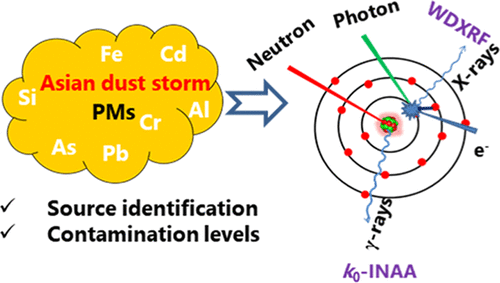当前位置:
X-MOL 学术
›
ACS Earth Space Chem.
›
论文详情
Our official English website, www.x-mol.net, welcomes your
feedback! (Note: you will need to create a separate account there.)
Chemical Composition of Asian Dust in Daejeon, Korea, during the Spring Season
ACS Earth and Space Chemistry ( IF 2.9 ) Pub Date : 2020-07-02 , DOI: 10.1021/acsearthspacechem.9b00327 Kishore B. Dasari 1 , Hana Cho 2 , Radojko Jaćimović 3 , Gwang-Min Sun 1 , Yong-Hyeon Yim 2
ACS Earth and Space Chemistry ( IF 2.9 ) Pub Date : 2020-07-02 , DOI: 10.1021/acsearthspacechem.9b00327 Kishore B. Dasari 1 , Hana Cho 2 , Radojko Jaćimović 3 , Gwang-Min Sun 1 , Yong-Hyeon Yim 2
Affiliation

|
Asian dust, which originates from the arid and loess regions of Central Asia, affects biological systems in remarkable ways in Northeast Asian countries. It contains a high amount of mineral dust composed of major metallic oxides, SiO2, Al2O3, CaO, and Fe2O3, which can cause adverse health effects upon high-level exposure. In the present study, Asian dust samples of spring seasons were collected for three consecutive years (2017–2019) and their elemental compositions were analyzed. A total of 42 major, minor, and trace elements were determined using two complementary analysis methods, wavelength-dispersive X-ray fluorescence spectrometry and k0-based instrumental neutron activation analysis. Sources of elements/dust and their contamination levels were evaluated using the data analysis tools including the HYSPLIT back-trajectory analysis, Pearson’s correlation, enrichment factor, and geoaccumulation index. Although the concentrations of Earth’s major crustal elements of the dust samples in spring seasons decreased appreciably for sampling events spanning 3 years, their major sources turned out to be the same, the Central Asia desert region, with negligible contaminations from the other sources. It was further supported by the back-trajectory analysis and the characteristic calcite compositions of different desert soils. This study successfully demonstrated the performances of combined data analysis tools for source identification, providing results with excellent consistency.
中文翻译:

春季韩国大田亚洲尘埃的化学成分
来自中亚干旱和黄土地区的亚洲尘埃以显着方式影响东北亚国家的生物系统。它包含大量由主要金属氧化物,SiO 2,Al 2 O 3,CaO和Fe 2 O 3组成的矿物粉尘,高剂量暴露会对人体健康产生不利影响。在本研究中,连续三年(2017-2019年)收集了春季的亚洲尘埃样品,并对它们的元素组成进行了分析。使用两种互补分析方法,波长色散X射线荧光光谱法和k 0,总共确定了42种主要,次要和痕量元素。基于仪器的中子活化分析。使用数据分析工具(包括HYSPLIT反向轨迹分析,Pearson相关性,富集因子和地积累指数)对元素/粉尘的来源及其污染水平进行了评估。尽管在3年的采样期内,春季春季尘埃样品中主要地壳元素的浓度明显下降,但事实证明它们的主要来源是相同的中亚沙漠地区,其他来源的污染却很少。背向轨迹分析和不同沙漠土壤的方解石成分特征进一步支持了这一点。这项研究成功地证明了用于源识别的组合数据分析工具的性能,提供了出色的一致性。
更新日期:2020-08-20
中文翻译:

春季韩国大田亚洲尘埃的化学成分
来自中亚干旱和黄土地区的亚洲尘埃以显着方式影响东北亚国家的生物系统。它包含大量由主要金属氧化物,SiO 2,Al 2 O 3,CaO和Fe 2 O 3组成的矿物粉尘,高剂量暴露会对人体健康产生不利影响。在本研究中,连续三年(2017-2019年)收集了春季的亚洲尘埃样品,并对它们的元素组成进行了分析。使用两种互补分析方法,波长色散X射线荧光光谱法和k 0,总共确定了42种主要,次要和痕量元素。基于仪器的中子活化分析。使用数据分析工具(包括HYSPLIT反向轨迹分析,Pearson相关性,富集因子和地积累指数)对元素/粉尘的来源及其污染水平进行了评估。尽管在3年的采样期内,春季春季尘埃样品中主要地壳元素的浓度明显下降,但事实证明它们的主要来源是相同的中亚沙漠地区,其他来源的污染却很少。背向轨迹分析和不同沙漠土壤的方解石成分特征进一步支持了这一点。这项研究成功地证明了用于源识别的组合数据分析工具的性能,提供了出色的一致性。











































 京公网安备 11010802027423号
京公网安备 11010802027423号